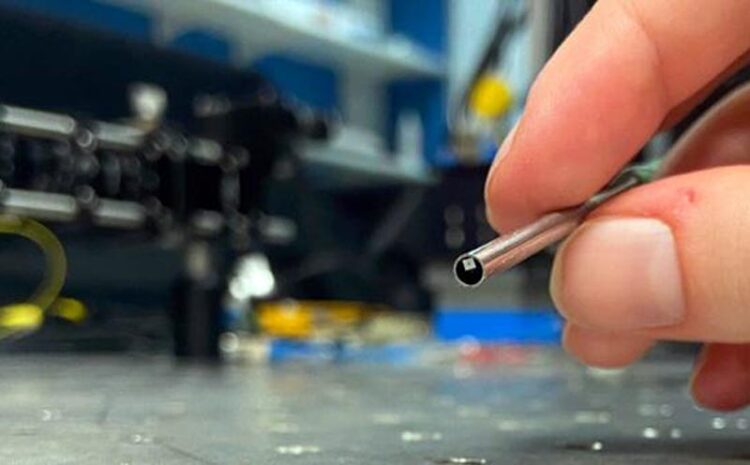System for early diagnosis of gastrointestinal cancers

The ultraminiature SFDI system is designed to be incorporated into colonoscopes. By leveraging the phenomenon of light interference, the endoscopic system can reveal information about the optical properties of tissue under investigation. In this photo, Dr. Jane Crowley holds a prototype device, in which the 3-mm diameter fiber tip encases the ultraminiature camera.
Credit: J. Crowley
Scientists develop a low-cost imaging device suitable for endoscopic screening programs.
Gastrointestinal cancers (GCs) are among the most common forms of cancer and account for as much as one-third of all cancer deaths worldwide. Early diagnosis is an effective way of reducing the mortality associated with GCs, and endoscopic screening has proved to be an excellent approach for detecting potentially malignant tumors.
To extend the benefits of screening programs to as many people as possible, the imaging systems used should be inexpensive to manufacture and operate, yet accurate enough to achieve low miss rates. To achieve this, scientists have been experimenting with different imaging modalities.
Among them, spatial frequency domain imaging (SFDI) is a promising technique for differentiating between healthy and malignant tissue. In SFDI, a repeating 2D pattern of light is projected onto a target area. By examining the intensity of the reflected light patterns, it is possible to derive information about the optical properties of the tissue under investigation, which can reveal the presence of cancerous lesions. Despite the simplicity and affordability of this imaging modality, however, current SFDI systems are too bulky to fit inside standard endoscopes, limiting their use in GC screening.
Against this backdrop, researchers Jane Crowley and George Gordon from University of Nottingham have recently developed an innovative SFDI device that shows promise for gastrointestinal endoscopy applications. Their study, published in the Journal of Biomedical Optics, could help make GC screening more widely accessible to the general population.
A major challenge in this study was finding a method to generate the light patterns necessary to perform SFDI in a convenient and cost-effective way. “Existing systems are not fit for routine endoscopic deployment in the gastrointestinal tract because they either use digital micromirror device-based projectors, which are costly and cannot be sufficiently miniaturized, or use fiber bundles which produce low-quality patterns at a limited set of wavelengths and only record low-resolution images, or use rigid endoscopes that are not flexible enough,” explains Crowley.
To overcome these issues, the researchers designed an ultraminiature SFDI system that uses a custom-made optic fiber bundle as a projector. The fiber bundle consists of seven optic fibers that can be independently coupled to laser sources of different wavelengths. By feeding a single laser of a given wavelength to two different fibers, one can leverage the phenomenon of interference to project a 2D sinusoidal pattern onto the target tissue. The spatial characteristics of the resulting pattern can be tuned by selecting different fiber pairs, and patterns consisting of up to three different wavelengths (such as green, red, and blue) can be projected simultaneously.
By combining this projection approach with an ultraminiature camera (1 mm x 1 mm), the researchers developed a prototype SFDI system with a diameter of just 3 mm. Moreover, using a custom algorithm that tracks phase deviations in the projected sinusoidal patterns, they managed to reduce noise in the captured absorption and scattering profiles.
Experiments with tissue phantoms mimicking the optical properties of healthy and cancerous tissues showed that the proposed device could provide excellent contrast between the two tissue types. More specifically, the specificity and sensitivity values for detecting squamous cell carcinoma were estimated to be over 90 percent, on par with the current clinical standards of medical devices.
The researchers remark that the proposed system could be miniaturized further to a diameter as small as 1.5 mm, allowing for minimally invasive endoscopic procedures. Additionally, its compatibility with multiwavelength imaging (using lasers of different colors) implies that the system could be used to capture optical information at different tissue depths, enabling the analysis of multiple tissue layers at the same time.
Together, the findings of this study showcase the potential of this innovative imaging approach for diagnostic applications. “Our prototype shows promise as a cost-effective, quantitative imaging tool to detect variations in optical absorption and scattering as indicators of cancer,” concludes Crowley. “This work could form the basis of new devices suitable for cost-effective endoscopic deployment for screening of gastrointestinal cancers.”
For details, read the original Gold Open Access article by Crowley and Gordon, “Ultra-miniature dual-wavelength spatial frequency domain imaging for micro-endoscopy,” J. Biomed. Opt. 29(2) 026002 (2024), doi 10.1117/1.JBO.29.2.026002.
Journal: Journal of Biomedical Optics
DOI: 10.1117/1.JBO.29.2.026002
Article Title: Ultra-miniature dual-wavelength spatial frequency domain imaging for micro-endoscopy
Article Publication Date: 1-Feb-2024
Media Contact
Daneet Steffens
SPIE–International Society for Optics and Photonics
daneets@spie.org
Office: 360-685-5478
All latest news from the category: Medical Engineering
The development of medical equipment, products and technical procedures is characterized by high research and development costs in a variety of fields related to the study of human medicine.
innovations-report provides informative and stimulating reports and articles on topics ranging from imaging processes, cell and tissue techniques, optical techniques, implants, orthopedic aids, clinical and medical office equipment, dialysis systems and x-ray/radiation monitoring devices to endoscopy, ultrasound, surgical techniques, and dental materials.
Newest articles

First-of-its-kind study uses remote sensing to monitor plastic debris in rivers and lakes
Remote sensing creates a cost-effective solution to monitoring plastic pollution. A first-of-its-kind study from researchers at the University of Minnesota Twin Cities shows how remote sensing can help monitor and…

Laser-based artificial neuron mimics nerve cell functions at lightning speed
With a processing speed a billion times faster than nature, chip-based laser neuron could help advance AI tasks such as pattern recognition and sequence prediction. Researchers have developed a laser-based…

Optimising the processing of plastic waste
Just one look in the yellow bin reveals a colourful jumble of different types of plastic. However, the purer and more uniform plastic waste is, the easier it is to…



